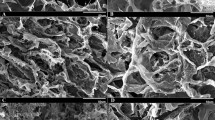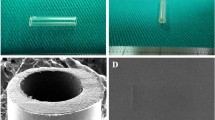Abstract
Nerve conduits have been paid attention to as a useful technique for bridging the gap between damaged peripheral nerve stumps. In particular, the development of nerve conduits with a higher porosity and surface area is necessary for providing the conditions needed for nerve tissue regeneration. Here we fabricated poly(lactic-co-glycolic acid)/poly(γ-glutamic acid)/Pluronic 17R4 nerve conduits containing three-dimensional bimodal pore structures using the thermally induced phase separation technique. The dope composition of polymers and separation temperature were found to significantly affect the fabrication of the nerve conduits; the optimum dope composition was found to be 58:19:23 at a concentration of 26 w/v%, and the optimum separation temperature was 40 °C. The results of bioactivity tests demonstrated that PP40 fabricated under the optimum conditions promoted more rapid Schwann cell proliferation than other nerve conduits because of their three-dimensionally interconnected bimodal pore structures, large surface area, and hydrophilicity. Our results suggest that neve conduits with bimodal open pore structures could be used as nerve graft substitutes for nerve regeneration.











Similar content being viewed by others
References
Wu H, Zhang J, Luo Y, Wan Y, Sun S (2015) Mechanical properties and permeability of porous chitosan-poly(p-dioxanone)/silk fibroin conduits used for peripheral nerve repair. J Mech Behav Biomed Mater 50:192–205
Daly WT, Knight AM, Wang H, de Boer R, Giusti G, Dadsetan M, Spinner RJ, Yaszemski MJ, Windebank AJ (2013) Comparison and characterization of multiple biomaterial conduits for peripheral nerve repair. Biomaterials 31:5789–5797
Luo L, Gan L, Liu Y, Tian W, Tong Z, Wang X, Huselstein C, Chen Y (2015) Construction of nerve guide conduits from cellulose/soy protein composite membranes combined with Schwann cells and pyrroloquinoline quinone for the repair of peripheral nerve defect. Biochem Biophys Res Commun 547:507–513
Rinker B, Vyas KS (2014) Clinical applications of autografts, conduits, and allografts in repair of nerve defects in the hand: current guidelines. Clin Plast Surg 41:533–550
IJkema-Paassen J, Jansen K, Gramsbergen A, Meek MF (2004) Transection of peripheral nerves, bridging strategies and effect evaluation. Biomaterials 25:1583–1592
Yao L, de Ruiter GCW, Wang H, Knight AM, Spinner RJ, Yaszemski MJ, Winnebank AJ, Pandit A (2010) Controlling dispersion of axonal regeneration using a multichannel collagen nerve conduit. Biomaterials 31:5789–5797
Wan Y, Huang J, Zhang J, Yin D, Zheng Z, Liao C, Sun S (2013) Investigation of mechanical properties and degradability of multi-channel chitosan–polycaprolactone/collagen conduits. Polym Degrad Stab 98:122–132
Hsu SH, Chan SH, Chiang CM, Chen CCC, Jiang CF (2011) Peripheral nerve regeneration using a microporous polylactic acid asymmetric conduit in a rabbit long-gap nerve transection model. Biomaterials 32:3764–3775
Liao C, Huang J, Shaofa S, Xiao B, Zhou N, Yin D, Wan Y (2013) Multi-channel chitosan–polycaprolactone conduits embedded with microspheres for controlled release of nerve growth factor. React Funct Polym 73:149–159
Nune M, Krishnan UM, Sethuraman S (2016) PLGA nanofibers blended with designer self-assembling peptides for peripheral neural regeneration. Mater Sci Eng C 62:329–337
Oh SH, Kim JH, Song KS, Jeon BH, Yoon JH, Seo TB, Namgung U, Lee I, Lee JH (2008) Peripheral nerve regeneration within an asymmetrically porous PLGA/Pluronic F127 nerve guide conduit. Biomaterials 29:1601–1609
Wang CC, Su CH, Chen JP, Chen CC (2009) An enhancement on healing effect of wound dressing: acrylic acid grafted and gamma-polyglutamic acid/chitosan immobilized polypropylene non-woven. Mater Sci Eng C 29:1715–1724
Akash MSH, Rehman K (2015) Recent progress in biomedical applications of Pluronic (PF127): pharmaceutical perspectives. J Control Release 209:120–138
Sundback C, Hadlock T, Cheney M, Vacanti J (2003) Manufacture of porous polymer nerve conduits by a novel low-pressure injection molding process. Biomaterials 24:819–830
Huang X, Wang W, Zheng Z, Wang X, Shi J, Fan W (2016) Dissipative particle dynamics study and experimental verification on the pore morphologies and diffusivity of the poly(4-methyl-1-pentene)-diluent system via thermally induced phase separation: the effect of diluent and polymer concentration. J Membr Sci 514:487–500
Jung JT, Kim JF, Wang HH, di Nicolo E, Drioli E, Lee YM (2016) Understanding the non-solvent induced phase separation (NIPS) effect during the fabrication of microporous PVDF membranes via thermally induced phase separation (TIPS). J Membr Sci 514:250–263
Amin ML, Kim D, Kim SJ (2016) Development of hematin conjugated PLGA nanoparticle for selective cancer targeting. Eur J Pharm Sci 91:138–143
Qiao T, Jiang S, Song P, Song X, Liu Q, Wang L, Chen X (2016) Effect of blending HA-g-PLLA on xanthohumol-loaded PLGA fiber membrane. Colloid Surf B Biointerfaces 146:221–227
Gu X, Ding F, Yang Y, Liu J (2011) Construction of tissue engineered nerve grafts and their application in peripheral nerve regeneration. Prog Neurobiol 93:204–230
Unnithan AR, Barakat NAM, Pichiah PBT, Gnanasekaran G, Nirmala R, Cha YS, Jung CH, El-Newehy M, Kim HY (2012) Wound-dressing materials with antibacterial activity from electrospun polyurethane–dextran nanofiber mats containing ciprofloxacin HCl. Carbohydr Polym 90:1786–1793
Quah BJC, Parish CR (2012) New and improved methods for measuring lymphocyte proliferation in vitro and in vivo using CFSE-like fluorescent dyes. J Immunol Methods 379:1–14
Torigoe K, Lundborg G (1998) Selective inhibition of early axonal regeneration by myelin-associated glycoprotein. Exp Neurol 150:254–262
Acknowledgements
This research was supported under the Framework of International Cooperation Program managed by the National Research Foundation of Korea (NRF-2015K2A2A4000128).
Author information
Authors and Affiliations
Corresponding author
Rights and permissions
About this article
Cite this article
Lee, JH., Kim, YJ. Effect of bimodal pore structure on the bioactivity of poly(lactic-co-glycolic acid)/poly(γ-glutamic acid)/Pluronic 17R4 nerve conduits. J Mater Sci 52, 4923–4933 (2017). https://doi.org/10.1007/s10853-016-0729-3
Received:
Accepted:
Published:
Issue Date:
DOI: https://doi.org/10.1007/s10853-016-0729-3




